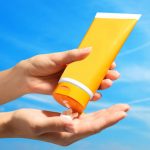FDA’s Rulings on Water Resistant Sunscreens
Formulations

Sunblock… Waterproof… Sweatproof… Because these words are used so often on sunscreen labels, we no longer know what they mean. Many brands just want to label the bottle with the most “proofs” and the highest possible SPF to make it attractive for consumers and call it good.

Sunblock... Waterproof... Sweat-proof... Because these words are used so often on sunscreen labels, we no longer know what they mean. Many brands just want to label the bottle with the most "proofs" and the highest possible SPF to make it attractive for the consumers and call it good.
Though the Indian regulations are not very clear on the usage of different terminologies, US FDA and European Regulations provide clearer guidelines and we tend to follow the same in the country as well.

US FDA Rules 2011
On June 14, 2011, the Food and Drug Administration (FDA) said that all over-the-counter sunscreens must now meet new rules. The goal of these new rules is to make sunscreens that are already on the market work better and make it easier for people to find and use them.
Well, this "sunscreen is obvious" way of thinking will soon be a thing of the past. The new FDA rules for sunscreen cover both UVA and UVB protection, as well as claims that the sunscreen is water and sweat proof. Some claims on sunscreen labels, like "waterproof," "sweatproof," and "sunblock," will no longer be allowed because the FDA thinks they are misleading. You will hear new words like "water resistant" and "very water resistant" more often.
What is the new rule about water resistance?
When these new rules go into effect next year, water resistance claims on product labels must say how long the user can expect the SPF protection to last while swimming or sweating. Based on standard tests, manufacturers can say how long their products can withstand water.
A sunscreen that says it can stand up to water must be tested by a third party. Volunteers will have sunscreen put on them as part of this test. After drying off for at least 15 minutes, the volunteer is submerged up to the middle of his or her back in water that is between 25 and 32 degrees Celsius and is moving slowly. The person stays in water for 20 minutes, after which they dry off for 20 minutes. For the 40-minute claim, this is done over and over again for a total of 40 minutes of water immersion. The sunscreen's real effectiveness is then measured after 40 minutes of being in water. This is the SPF number that can be put on the bottle of sunscreen that says it can be used in the water for 40 minutes. Tests for things that are very resistant would be repeated until a total of 80 minutes of immersion has passed. If a product doesn't say that it is water resistant, the label must tell people to use a water-resistant sunscreen when they swim or sweat.
The European standard for testing water resistance
The European standard for testing water resistance was set in 2005. There are two tests, one that lasts 40 minutes and one that lasts 80 minutes. There is a 15-minute dry time between each immersion. Temperature is 29 degrees Celsius +/- 2 degrees. For water resistance to be claimed, the SPF must be more than or equal to 50% after immersion at a 90% confidence interval.
So, how often should you direct to reapply on your label?
The FDA says at least once every two hours. If a product says it is "water resistant," reapply it after 40 minutes of vigorous activity in water. If it says it is "very water resistant," apply it again after 80 minutes. The same is true if you have been sweating a lot or have used a towel. Always remember that it is better to be safe than sorry. Here are some tips from the FDA on how to guide customers to stay safe in the sun:
• Always use broad-spectrum sunscreens with an SPF of 15 or higher, and do so as directed.
• Stay out of the sun as much as possible, especially between 10 a.m. and 2 p.m., when the sun's rays are the strongest.
• Wear clothes that cover skin that will be in the sun, like long-sleeved shirts, pants, sunglasses, and wide-brimmed hats. Reapply sunscreen at least every two hours, or more often if you're sweating or jumping in and out of the water.